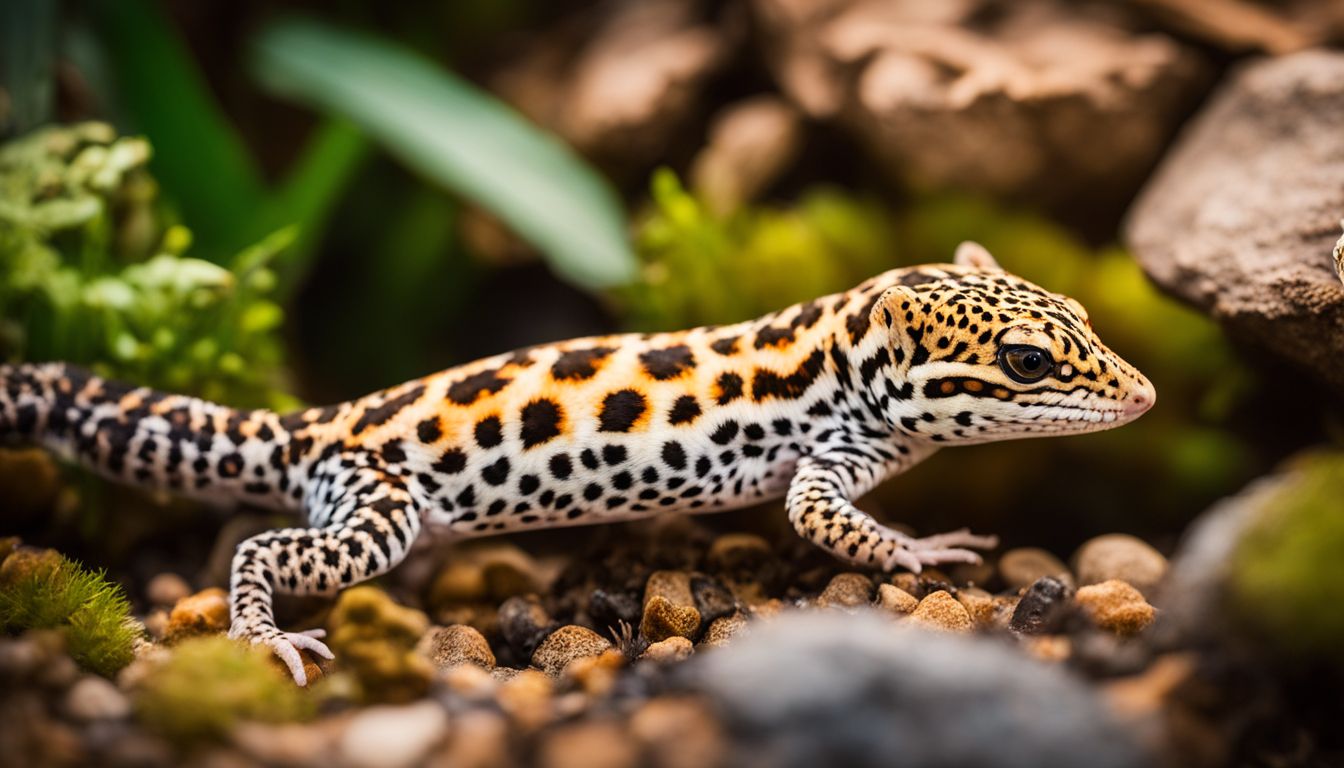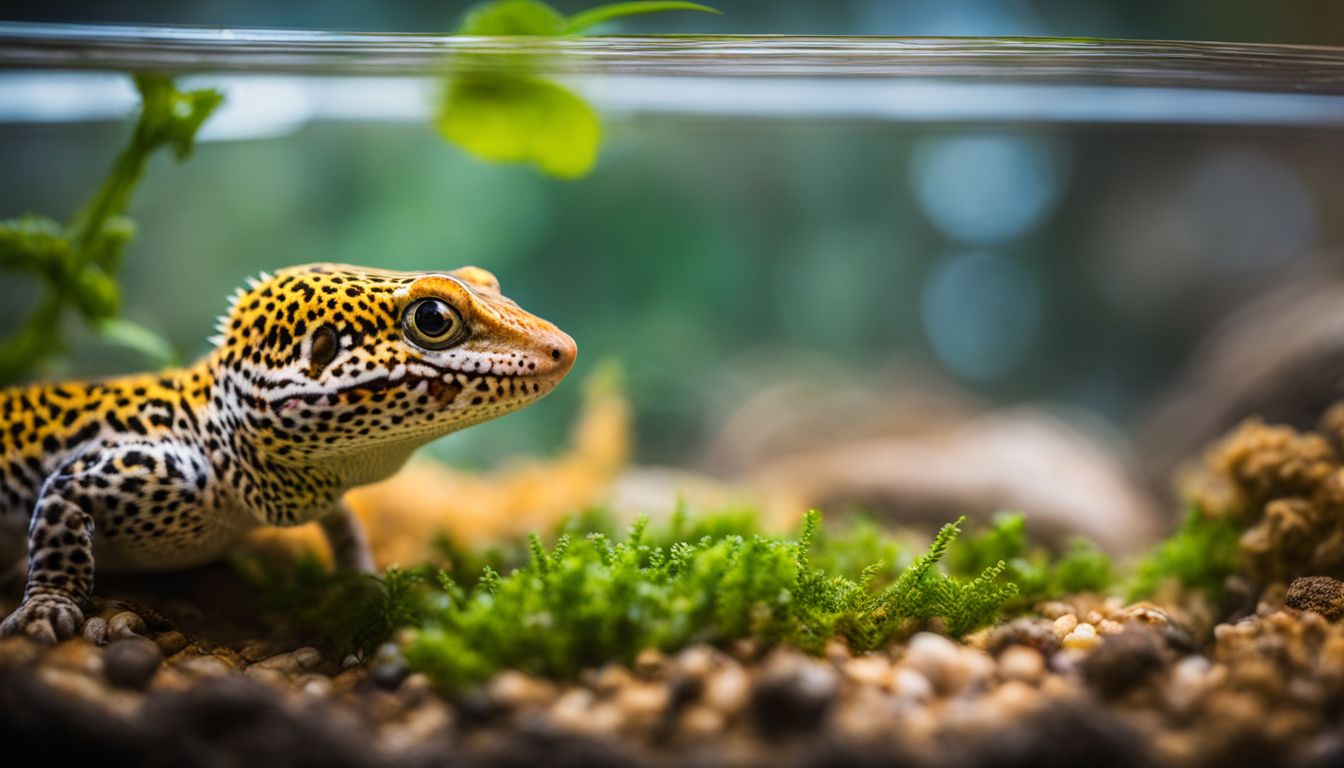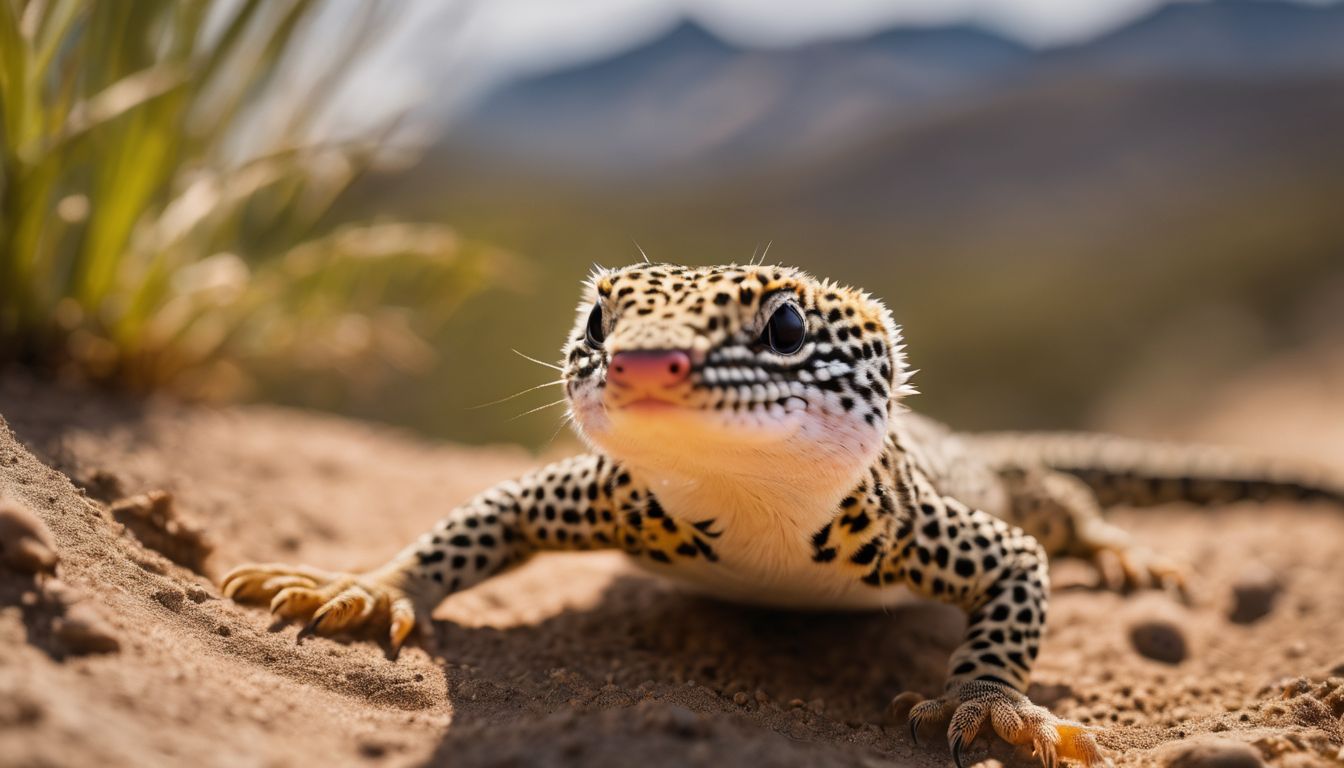Have you ever watched your leopard gecko and wondered if those little rolly pollies scuttling across the garden could be more than just quirky backyard critters? Like any responsible pet owner, you want to provide the best diet for your scaled companion, but with so much information out there, it’s hard to know what’s safe to add to their menu.
One fact stands out: Rolly pollies are packed with calcium which is essential for your gecko’s health.
In this guide, we’ll dive into whether these tiny armored bugs can safely become a part of your leopard gecko’s diet. From understanding what rolly pollies are all about to recognizing signs of distress in your pet when trying new foods, we’ve got the insights you need.
Get ready to learn how these creatures can benefit your reptile friend and the right way to serve them up as a tasty treat! Keep reading for all the do’s and don’ts that will help keep your leopard gecko healthy and happy.
Key Takeaways
- Rolly pollies, also known as sowbugs or isopods, can be a beneficial part of a leopard gecko’s diet due to their high calcium content that supports bone health and development.
- Feeding rolly pollies to geckos can stimulate natural prey behavior, keeping them mentally and physically healthy by preventing boredom and promoting an enriched feeding experience.
- However, potential risks such as impaction from the hard exoskeletons and exposure to pesticides or parasites need consideration. It’s essential to offer these insects in moderation alongside other nutritious insects for a balanced diet.
- Other alternative nutritious insects for leopard geckos include crickets, mealworms, fruit flies, cockroaches, dubia roaches, black soldier fly larvae (Phoenix Worms), silkworms, waxworms, butterworms which should be gut-loaded with nutritious foods before being fed.
Understanding Rolly Pollies: A Potential Food Source?

Rolly pollies, also known as sowbugs or isopods, are small crustaceans that can potentially be a food source for leopard geckos. They are high in protein and can offer nutritional benefits to your gecko’s diet.
What are Rolly Pollies?
Rolly pollies are small, round bugs that can curl into a ball when scared. Their real name is pill bugs or isopods. These little creatures crawl around on the ground and eat dead plants.
They have a hard shell on their back which is rich in calcium. This calcium helps them grow strong just like it does for leopard geckos.
Pill bugs make a crunchy snack for your gecko because of their exoskeletons. Geckos need lots of calcium to keep their bones healthy, so rolly pollies fit right into their diet. But remember, even if they’re good for your pet, you still need to give them different kinds of food too.
Next, let’s find out what nutrients these tiny critters offer to our scaly friends!
Nutritional Content of Rolly Pollies
After understanding what rolly pollies are, it’s important to consider their nutritional value before introducing them to a leopard gecko’s diet. Pill bugs can be a nutritious snack for your gecko due to their calcium content.
| Nutrient | Benefit to Leopard Geckos |
|---|---|
| Calcium | Essential for bone health and development |
| Protein | Supports growth and tissue repair |
| Fat | Provides energy, but should be limited |
| Chitin | Exoskeleton may aid digestion, but poses impaction risk |
| Moisture | Hydration is crucial for geckos’ health |
| Fiber | Beneficial for digestive health |
With their exoskeletons offering a source of calcium, pill bugs can help maintain the bone health of your gecko. Protein within these creatures aids in the gecko’s growth, while their fat content should be moderated. Chitin, found in their hard shells, may also assist with digestion, though too much can lead to impaction. Adequate moisture and fiber found in rolly pollies also make them a potentially healthy food choice. However, they should be a part of a varied diet to ensure comprehensive nutrition.
The Pros of Feeding Rolly Pollies to Leopard Geckos

Rolly pollies have calcium-rich exoskeletons, which can provide essential nutrients for the bone health of leopard geckos. Additionally, feeding these insects can stimulate natural prey behavior in geckos, promoting a more enriching feeding experience.
Calcium-Rich Exoskeletons for Bone Health
Leopard geckos need calcium for strong bones and good health. Rolly pollies have hard shells full of calcium, which helps the bone growth in these little reptiles. Eating these bugs can make their skeletons tough and ready for all the climbing and moving they do.
Geckos find rolly pollies exciting to hunt because they roll up into balls. This keeps mealtime fun and natural for them. It’s just like what they would do in the wild, chasing down their food.
Next, let’s explore how rolling after prey boosts a gecko’s mood and skills.
Natural Prey Behavior Stimulation
Rolly pollies can stimulate the natural hunting instincts of leopard geckos. When they hunt and eat live prey like isopods, it replicates their behavior in the wild. This stimulation helps keep them active and engaged, preventing boredom and promoting a more natural lifestyle for these reptiles.
Providing opportunities for natural prey behavior stimulation can contribute to the overall wellbeing of leopard geckos by keeping them mentally and physically healthy.
Now let’s delve into the potential risks associated with incorporating rolly pollies in a gecko’s diet.
The Cons and Risks of Rolly Pollies in a Gecko’s Diet
Potential for impaction and exposure to pesticides and parasites are two main risks associated with feeding rolly pollies to leopard geckos. Understanding these concerns is crucial when considering this food source for your pet.
Potential for Impaction
Rolly pollies have a hard exoskeleton that can be difficult for leopard geckos to digest. This can cause blockages in their digestive system, leading to impaction and potential health issues.
It’s important to monitor the size of the prey insects offered to ensure they are suitable for your gecko’s size and age, reducing the risk of impaction. Providing a varied diet with other small insects alongside rolly pollies can help lower the risk of impaction.
Next, let’s delve into “Exposure to Pesticides and Parasites” when considering feeding rolly pollies to leopard geckos.
Exposure to Pesticides and Parasites
Rolly pollies might have been exposed to pesticides or parasites. This is because they live in the wild and can come into contact with these harmful substances. When feeding rolly pollies to leopard geckos, it’s important to ensure they are from a safe source and haven’t been exposed to any chemicals or parasites that could harm the gecko’s health.
It’s vital to prioritize the safety of your pet by providing clean and healthy food options.
Best Practices for Incorporating Rolly Pollies
When offering Rolly Pollies to your leopard gecko, it’s essential to do so in a safe and controlled manner. Proper storage and preparation are key for ensuring the health and wellness of your pet.
How to Safely Offer Rolly Pollies
To safely offer rolly pollies to your leopard gecko, follow these steps:
- Gut-load the Rolly Pollies: Feed them a nutritious diet before offering them to your gecko, ensuring they are packed with essential nutrients.
- Dust the Rolly Pollies: Before feeding them to your gecko, dust the rolly pollies with a calcium supplement to enhance their nutritional value.
- Offer in Moderation: Introduce rolly pollies gradually and in moderation as part of a varied diet for your gecko.
- Watch for Consumption: Monitor how many rolly pollies your gecko consumes to prevent overeating and ensure they are accepting this new food item.
- Check for Parasites: Inspect the rolly pollies for any signs of parasites before offering them to your gecko, ensuring they are safe to consume.
- Remove Uneaten Rolly Pollies: If any rolly pollies remain uneaten after a few hours, remove them from the enclosure to maintain cleanliness.
Proper Storage and Preparation
When considering adding rolly pollies to your leopard gecko’s diet, it’s important to ensure proper storage and preparation. Here are some tips to safely offer rolly pollies to your gecko:
- Purchase organic or pesticide – free rolly pollies from a trusted source to avoid any exposure to harmful chemicals.
- Keep the rolly pollies in a separate enclosure with proper ventilation, food, and moisture until they are ready to be fed to your gecko.
- Gut-load the rolly pollies by feeding them nutritious foods like vegetables, fruits, or commercial gut-loading products before offering them to your gecko.
- Dust the rolly pollies with calcium powder before feeding them to ensure that your leopard gecko receives an adequate calcium intake.
- Only offer appropriately sized rolly pollies based on the size of your leopard gecko’s mouth to prevent choking hazards.
Recognizing Signs of Distress in Leopard Geckos When Introducing New Foods
Recognizing Signs of Distress in Leopard Geckos When Introducing New Foods:
1. Look for changes in appetite, such as refusing to eat or a sudden decrease in the amount of food consumed.
2. Keep an eye out for any unusual behaviors, like lethargy or excessive hiding, which could indicate stress or discomfort.
3. Monitor their weight and body condition regularly to ensure they are maintaining a healthy size and shape.
4. Watch for signs of digestive issues, such as diarrhea or constipation, that may be linked to the new food item.
5. Pay attention to any changes in their skin appearance, including dryness or shedding difficulties, which could be related to dietary imbalances.
6. Seek veterinary guidance if you notice persistent signs of distress or if your gecko’s overall health is negatively affected by the introduction of new foods.
Remember that it’s essential to observe your leopard gecko closely when introducing new foods into their diet to ensure their well-being and adjust accordingly based on their reactions.
Alternatives to Rolly Pollies for a Balanced Diet
Other Nutritious Insects for Leopard Geckos include crickets, mealworms, fruit flies, and cockroaches. These insects provide a balanced diet for leopard geckos and can be easily found in pet stores or obtained through online suppliers.
Other Nutritious Insects for Leopard Geckos
Leopard geckos can eat a variety of insects to ensure a balanced and nutritious diet. Here are some other options to consider:
- Crickets: These are a staple in the leopard gecko’s diet, providing essential protein and nutrients.
- Mealworms: A good source of fat and protein for leopard geckos, especially for adults.
- Dubia Roaches: Rich in protein and low in chitin, making them easy to digest for geckos.
- Black Soldier Fly Larvae: High in calcium and low in fat, ideal for young or breeding geckos.
- Silkworms: Known for their high protein content and low-fat levels, they are a great occasional treat.
- Waxworms: High in fat, they should be fed sparingly to prevent obesity but can be useful for underweight or malnourished geckos.
- Butterworms: Another high-fat option that should be given as an occasional treat due to their high-caloric content.
- Phoenix Worms (Black Soldier Fly Larvae): High in calcium and suitable for all life stages of leopard geckos.
Conclusion
In conclusion, incorporating rolly pollies into a leopard gecko’s diet can provide essential calcium for their bone health. Properly offering and preparing rolly pollies can ensure the safety and nutritional benefits for your geckos.
While they should not be the sole diet, adding them to other insect options can create a complete and balanced nutritional intake. By being mindful of potential risks and following best practices, you can enhance the overall well-being of your leopard geckos.
Take these practical steps to ensure your pets have a diverse and nutritious diet that supports their growth and development.
If you notice any unusual behavior when introducing new foods to your leopard gecko, learn how to interpret the signs with our guide on determining if your leopard gecko is dead or hibernating.
FAQs
1. Can leopard geckos eat rolly pollies?
Yes, leopard geckos can eat rolly pollies, also known as woodlice or isopods, as part of their diet.
2. Are rolly pollies a suitable regular food for leopard geckos?
Rolly pollies should be offered occasionally and not as a primary food source for leopard geckos due to their high chitin content.
3. Should I give my leopard gecko any special supplements if they eat rolly pollies?
Supplements like calcium and vitamin D3 should still be provided to ensure your leopard gecko gets all the necessary nutrients even when eating rolly pollies.
4. How many rolly pollies can I feed my leopard gecko at a time?
It’s best to offer 2-4 appropriately sized rolly pollies per feeding session depending on the size and age of your leopard gecko.
5. What other foods should I include in my leopard gecko’s diet besides rolly pollies?
A varied diet including gut-loaded insects like crickets, mealworms, waxworms, and occasional treats such as silkworms or hornworms is important for the overall health of your pet leopard gecko.




